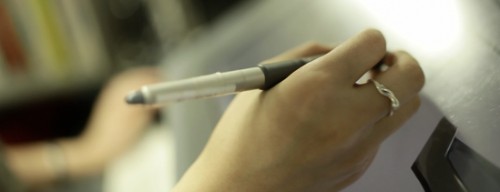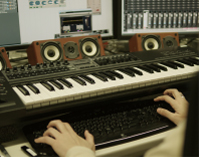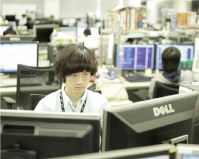(Continues from Part 1.)
Sharing your Vision
Funahashi: It’s my 4th year here at Platinum, and I can finally say I’ve gotten the hang of my job. Thinking back to when I just started, every day was a struggle. I had no idea what the director was trying to convey… I would make exactly what they told me to, only to have it thrown back in my face with a “This isn’t even close!” I just had no idea what was what back then.
Ohkura: Yeah, we’ve all been there. Problems like that can be solved by properly sharing your ideas regarding the overall feel of the world, but most people will have no idea how to give form to that when they’re only just starting out.

Shindo: In order to give a game’s world the proper feel, you must infer the intent behind the director’s words, and find your own answer to that somehow. That’s all much easier said than done, obviously. At first I was so preoccupied with trying to understand the game world and doing exactly what the director told me, that I couldn’t make any progress at all. I remember being surprised listening to the sounds my seniors came up with all by themselves, and thinking “Yeah, I guess that works too!” That’s how I started coming up with my own ideas as well, because I figured that it was okay to make mistakes sometimes.
Funahashi: For example, let’s say the director asks you to make a chair. You have to consider, do they want something with the shape of a chair, or something with the function of a chair, i.e. something people can sit on? If we’re talking about the function, even a simple wooden log or a guard rail could be considered a “chair.” If the vision of the game world is clearly shared between all of the staff, you will begin to understand it by nature, and you will no longer be constrained by the words you are given.
 Shindo: On the other hand, there were times when, even if I asked the director what kind of sound he was looking for, I would just get a vague answer like “Hmmm, I dunno… something that sounds cool!” That’s not much to work with, haha. What sounds “cool” is obviously highly subjective, so in order to find a cool sound that fits within the world of the game, the only thing you can do is to just create a massive number of different sounds and see what sticks.
Shindo: On the other hand, there were times when, even if I asked the director what kind of sound he was looking for, I would just get a vague answer like “Hmmm, I dunno… something that sounds cool!” That’s not much to work with, haha. What sounds “cool” is obviously highly subjective, so in order to find a cool sound that fits within the world of the game, the only thing you can do is to just create a massive number of different sounds and see what sticks.
Funahashi: Yeah, I’ve also been given instructions like “Gimme something that looks nice!”, which tends to fill me with joy and terror simultaneously, haha. If you don’t have a proper grasp on the game world, nothing you propose is going to work. However, knowing that you’ve been given this chance, despite the risk of failure, can be invigorating. It makes you want to create something that will live up to expectations.
Ohkura: I often start working on projects before they even have a solid world or character details, so I begin by just getting my pen moving and seeing what takes shape. Explaining things verbally is not my strong suit, so when the director and I share our views of the game world, I make sure to bring plenty of visual aids. It makes me so happy when I finally hear, “Yes! Let’s go with this!”
Shindo: In that sense, it feels like you’re shaping the world with your own hands. There are a lot of things that you come to understand when the team shares the flow and overall direction of the game with each other, while going through a process of trial and error. It really feels like all the individual parts come together to form the whole.
Ohkura: I know what you mean. I love when I’m trusted with a task that I have full creative control over – most of the time. Based on a character’s back story, I imagine how they would react in certain situations, and over time the little details of the game’s world are formed. Of course there are times when one of my ideas doesn’t work in the established world setting, but there’s nothing stopping you from thinking up additional back story as you go. To do this, we’re always being challenged to be more creative, and I’m sure the director has this is mind when he gives us these vague directions.
 Shindo: Yeah, and they always choose simple key words for you. However, that doesn’t mean I don’t still spend a lot of time having no clue what direction to take things in. And it’s times like that that the people around you often help you out by making suggestions. Instead of just banging your head against the wall alone, it’s more like a team searching for the best way to smash through the wall together. Uh… not literally of course.
Shindo: Yeah, and they always choose simple key words for you. However, that doesn’t mean I don’t still spend a lot of time having no clue what direction to take things in. And it’s times like that that the people around you often help you out by making suggestions. Instead of just banging your head against the wall alone, it’s more like a team searching for the best way to smash through the wall together. Uh… not literally of course.
Funahashi: There are certainly times when your idea ends up getting struck down, no matter how well it seems to go down during the team meeting. Those moments where everyone is excited about a certain idea are important, though – it’s a great way of reaffirming a shared vision of the game, which keeps the team going strong.
Shindo: In that sense, the development for Bayonetta was really exciting. It started out as a very serious world, but there were some funny parts as well. I would make some weird sound thinking, “Man, it’d be hilarious if we could use this,” and then the director, Kamiya, actually ended up putting it in the game. When he heard the sound he went, “Heh, this sounds so dumb… let’s use it!” I’ll never forget how happy I was that day.
Ohkura: While developing Bayonetta, there were a couple of times when the sounds Shindo created directly inspired my designs, actually.
Shindo: For example, I thought it would be cool if two of the characters could communicate with each other during a shooting stage. However, this wasn’t originally part of the game, so after I made the sounds, Ohkura actually came up with designs for communication devices they could use. As a sound designer I never thought I would be able to have that kind of influence on a game’s design.
(Continues to Part 3.)
interview by editorial studio MUESUM (2012/07/20)